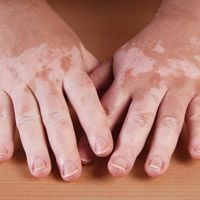Study Suggests Chemical Exposure May Contribute to Vitiligo Occurrence
New data suggests occupational exposure to certain melanocytotoxic chemicals may lead to vitiligo.

New research suggests that the occurrence of vitiligo may in part be brought upon by exposure to chemicals in an occupational or household setting, with exposure to phenols and catechols raising the risk by 4 times.
The case-control study was designed to assess contributing factors to the skin condition, with many having been implicated previously including anxiety, sunburn, hormones, and cytotoxic chemical factors.
The study’s investigators cite previous evidence indicating that melanocytotoxic chemicals, such as catechol and phenolic derivatives, may lead to vitiligo. Therefore, they identified a need to explore the association further.
The study was led by Nehla Rmadi, from the Occupational Department and Health Disease Hedi Chaker University Hospital at the University of Sfax in Tunisia.
“To our knowledge, few epidemiological studies are available on vitiligo induction factors and particularly on the role of exposure to chemicals in the onset of the disease has been found,” Rmadi and colleagues wrote. “Therefore, there is a need to investigate the relationship between vitiligo and chemical exposures in order to understand this mysterious disease.”
Research and Methods
The investigators used a case-control study of patients with diagnoses of vitiligo, using a minimum sample size of 46 cases and 92 controls. The total period of study was from July through December of 2019.
Those participants in the control arm were matched by age, gender, and professional status to those in the vitiligo arm.
The participants’ data collected by the investigators included the following pieces of information:
- Age, professional status, gender, and origin (urban or rural)
- Environmental chemical exposure including a residence with a nearby polluted area, having a household chemical history, colored toothpaste usage, hair dye usage, cosmetics, deodorants, scented oils
- Medical information such as family vitiligo history and repeated antibiotic use
- Information on occupational chemical exposure prior to vitiligo such as positions with exposure occupied for over half a year, professional tenure, and exposure to these chemicals: MonoBenzyl Ether of Hydroquinone (MBEH), phenol or catechol derivatives, disinfectants, detergents, and insecticides or pesticides
Study Results
The study results indicated that household chemical use was a risk factor for vitiligo (P = 0.00; OR = 2.6; 95% CI = [1.27 – 5.55]), colored toothpaste use was a risk factor (P = 0.02; OR = 2.89; 95% CI = [1.10 – 7.61]), and a residence close to pollution was a risk factor (P = 0.00; OR = 3; 95% CI = [1.33 – 6.79]).
The research team also added that patients with a repeated history of antibiotic use showed a 5.1 fold increase in vitiligo risk (P = 0.00; IC95% = [2.26 – 11.49]), and that occupational chemical exposures to phenol/catechol derivatives were found to be significantly associated (P = 0.01; OR = 2.9; 95% CI = [1.18 – 7.12]).
The investigators note that the widespread application of phenols as an ingredient in commercial products for households such as toothpaste, hair dye, and others, may be a contributor. They added that oxidative stress may also contribute.
“Our results suggest that chemical factors play a key role in the occurrence of vitiligo,” they wrote. “Therefore, prevention of this dermatosis requires the identification of exposure to the incriminated chemicals in any patient followed for vitiligo.”
The study, “Role of chemical exposure in the incidence of vitiligo: a case–control study in Tunisia,” was published in the Libyan Journal of Medicine.